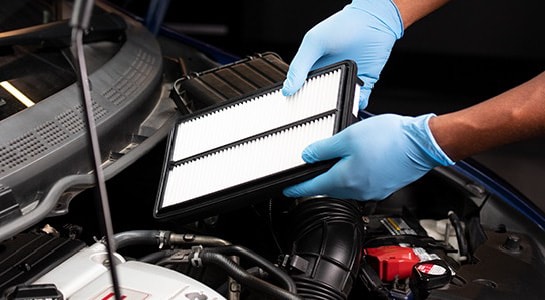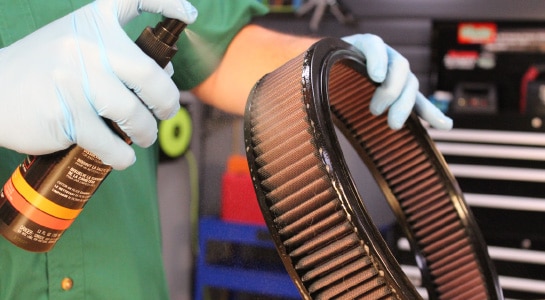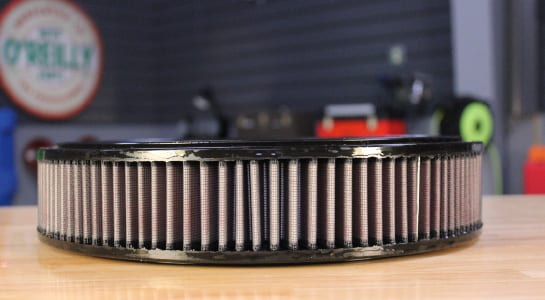Conventional air filters are the typical filter you would find installed in most vehicles from the factory. Conventional filters are composed of thick paper or a foam-based element, and this composition can restrict airflow into the intake system. Due to the thickness of conventional filters, little to no harmful contaminants in the air are able to break through, ensuring only clean and debris-free air can be mixed with fuel. Because of this, conventional air filters may be optimal for especially dry, dusty, or polluted climates. Collecting these contaminants often leaves a layer of dirt or grime on the outer layer of the filter, and this can eventually result in a clog. As the contaminants build up, airflow becomes even more restricted and can prevent the engine from receiving the air it needs to run efficiently. This may cause a reduction in fuel mileage, performance, and even engine issues. Conventional filters are often very inexpensive but also built for normal, highway driving conditions and need to be regularly inspected to determine their condition. If they are clogged or especially dirty, they should be replaced as soon as possible.
Air filters are the first line of defense against dirt, dust, and debris entering your engine through the air intake system. Air intake systems deliver air from outside the vehicle into the engine’s throttle body, intake plenum, and manifold, and eventually into the cylinder for combustion. The air is then mixed with fuel in an appropriate ratio, and the mixture is ignited by a spark from the ignition system to create power. The air filter in all intake systems is responsible for filtering the air brought into the system, trapping any harmful contaminants that could damage the engine or reduce power. Air filters are not only a regular service item that should be part of your routine maintenance, but the quality and condition of your air filter can have a noticeable effect on gas mileage and the amount of power your engine can produce. Air filters are available in a few varieties, and replacing your conventional air filter with a high-performance oiled air filter may allow you to unlock more of your engine’s potential. Read on to learn more about oiled air filters.
Since the air filter in a vehicle’s air intake system is such a vital component of its performance and efficiency, being aware of filter options and the advantages of each filter type is valuable information when deciding what filter is the overall best fit for your vehicle. There are two types of air filters available for air intake systems: oiled air filters and conventional air filters. Below, you can learn more about each filter’s composition and benefits.
Conventional Air Filter Maintenance
While conventional filters are not typically reusable, there are ways to maintain conventional filters to ensure optimal performance throughout their life. To clean a conventional engine air filter, you can use compressed air to knock particles loose from the filter element, reducing the amount of dirt on the filter to improve airflow. This may work for a while, but you will eventually need to replace a conventional air filter to ensure continued performance and efficiency. If you’re not sure when to replace your air filter, take a look at your vehicle’s service manual or owners manual. These resources will provide recommended service dates and mileage intervals for a variety of filters, including air filters, as well as a step-by-step guide that covers how to properly replace and clean them. Though these intervals can be used as a guide, if you notice a reduction in performance or efficiency, it may be best to go ahead and replace or upgrade your air filter.
Oiled Air Filter Maintenance
These filters must be serviced regularly, including being cleaned and oiled using specific chemicals to allow them to continue working efficiently. Over-oiling your air filter can allow excess oil to seep through the cotton filter and enter the airstream, potentially damaging the mass air flow (MAF) sensor in the intake system. In order to complete your filter maintenance correctly, it is important to follow the instructions either on the packaging of your filter or the oil and service kit. Installing an oiled air filter is often just as easy as installing a conventional filter, as most come pre-oiled and ready to install in exactly the same way you would install any other air filter. But once the filter has been installed, maintenance and oiling become a much more important factor to keep your air filter working its best. If you follow regular maintenance checks, oiled air filters can outlast almost any conventional air filter, while increasing your intake system’s performance.
How to Clean and Maintain Engine Air Filters
Maintaining your car’s air filter doesn’t have to be hard when you have the right resources to get the job done. Whether you are cleaning or replacing a conventional air filter, or are cleaning and oiling an oiled air filter, these maintenance tasks take little time and are very easy to complete.
Step 1. Locate Your Vehicle’s Air Filter Housing
Most engine air filters are located under the hood of the vehicle and are protected by plastic or metal housing. This housing is often in the shape of a square or rectangle and is usually black in color. Inside the housing, you will find the air filter.
Step 2. Remove the Air Filter Housing Cover
To protect the air filter and prevent debris or dirt from damaging the system, a cover will be secured on top of the air filter housing by screws or clamps, depending on the type of vehicle. The specific tool needed to remove the housing cover can be found in your vehicle’s service manual. Typically, you will need to use a screwdriver or nut driver, or for vehicles with filter housings secured by protective clamps or clips, you will need a clip remover or flathead screwdriver, or you may be able to simply pop the clips loose by hand. After loosening and removing the screws or clips, wipe off the top of the housing to prevent any dirt or debris from flaking off into the air filter box.
Step 3. Remove the Air Filter
After removing the housing cover, you will be able to easily locate the air filter. The filter should lift out of the housing easily when you pick it up. It may be a good idea to take a picture before removing the air filter to ensure you know how to reinstall it. After the air filter is up and out of the housing, remove any leaves or large pieces of debris from the housing and use a clean rag to wipe any leftover dirt or debris from the interior of the housing and the sealing surface. While you’re cleaning the housing, you should also inspect it for any noticeable cracks in the casing or any other damage to the interior or exterior of the housing. You can also inspect the air intake hose, clamps, and connections for any potential leaks or cracks.
Step 4A. Cleaning Conventional Air Filters
If you are cleaning your conventional air filter, you can simply use compressed air to remove any dust or debris from the filter. If you use compressed air, make sure you are pushing the dirt and debris back out the way it came in and not through the filter. If you push the dirt through the filter, it can cause more dirt and debris to be trapped inside, decreasing the airflow even more. If you have a small, handheld vacuum or a vehicle detailing vacuum, you can also use the bristle brush attachment to remove any additional dust or dirt from the filter. Because these filters are typically not washable, you will only be able to use compressed air so many times before replacing the filter.
After applying the oil evenly around the filter, let the oil soak in for 15 to 20 minutes before reinstalling the filter in its housing. Touch up the filter and filter housing as necessary for optimal performance and uniform application. For more details specific to your vehicle, you can take a look at your owners manual or service manual, or the product instructions from your air filter manufacturer, for step-by-step oiled air filter service instructions. Most vehicles are not manufactured with oiled air filters, and will likely not have specific instructions for oiled air filter maintenance in the service manual. If this is the case, refer to the oiled air filter product instructions, or follow up with our Professional Parts People® for more helpful information. Visit O’Reilly Auto Parts to find the air filter oils, cleaners, and complete service kits you need to get the job done right.
How Often Should Air Filters Be Serviced?
Conventional air filters that are primarily used in highway environments should usually be cleaned or changed once a year, or every 12,000 to 15,000 miles, whichever comes first. If your air filter is subject to overly dry or dusty environments, you will likely need to change your filter at an earlier service date. Regularly checking the condition of your air filter is the best way to know if your filter is due for some needed maintenance or attention. If you notice an unusual loss of engine power, reduced gas mileage, or decreased performance, check your air filter for any clogs caused by harmful contaminants. Some conventional air filters come with a service life indicator on the filter that is designed to alert you when it is time for the filter to be replaced. Always refer to your vehicle’s service manual for specific maintenance intervals to keep your vehicle running in top shape.
Oiled air filters typically do not need to be replaced as often as conventional filters, but they do need to be cleaned and oiled at regular intervals. Many drop-in replacement oiled air filters can last up to 75,000 to 100,000 miles before needing to be serviced if they are used in normal highway and driving conditions. In extremely dry, dusty driving conditions, you will likely need to clean and re-oil your filter sooner, depending on the level of visible filter contamination. If maintained properly, oiled air filters can be cleaned and re-oiled rather than being replaced for long periods of time. However, there are some oiled filters that cannot be cleaned or re-oiled and must be replaced when dirty. Most vehicles are not manufactured with oiled air filters, so your service manual may not provide the information you need to perform this service. For more information about when to service oiled air filters, check the manufacturer’s recommendations on the packaging of your air filter.
Bad Air Filter Symptoms
Recognizing the signs of a clogged or dirty air filter can help you stay up-to-date with needed air filter maintenance. Some of the most common clogged air filter signs are poor or below-average engine performance, engine misfires, loss of power, reduced acceleration, unusual engine noises, reduced gas mileage, or an illuminated Check Engine light. If any or a combination of these symptoms are occurring, inspect your air filter for any clogs, an excessive amount of filter contamination, or filter damage.
Air Filter Necessities
Engine air filters, whether oiled or conventional, require specific maintenance and tools to perform efficiently. O’Reilly Auto Parts carries air filter tools and supplies that can help you complete your filter maintenance checklist or repairs faster, and our Professional Parts People can help you find the filter you need to help you get the job done right the first time. We offer the supplies and upgrades you need to install a K&N air filter or cold air intake system, and all of the parts to increase your engine’s performance and power, including K&N>filter oils and cleaners, replacement oiled air filter kits, and K&N cold air intakes and cleaners. If you want to learn more about replacing the air filter in your vehicle, the O'Reilly How-To-Hub is also full of great step-by-step instructions for changing air filters. If you have questions about your vehicle’s air intake system and its required maintenance or parts, refer to your vehicle’s service manual for all of the information you need.
Shop K&N Air Filters
O’Reilly Auto Parts carries K&N oiled air filters, intake kits, filter cleaning kits, and more for your vehicle. Shop K&N filters and parts to maximize your vehicle’s performance.







